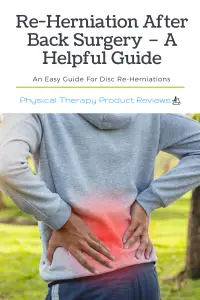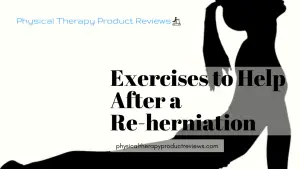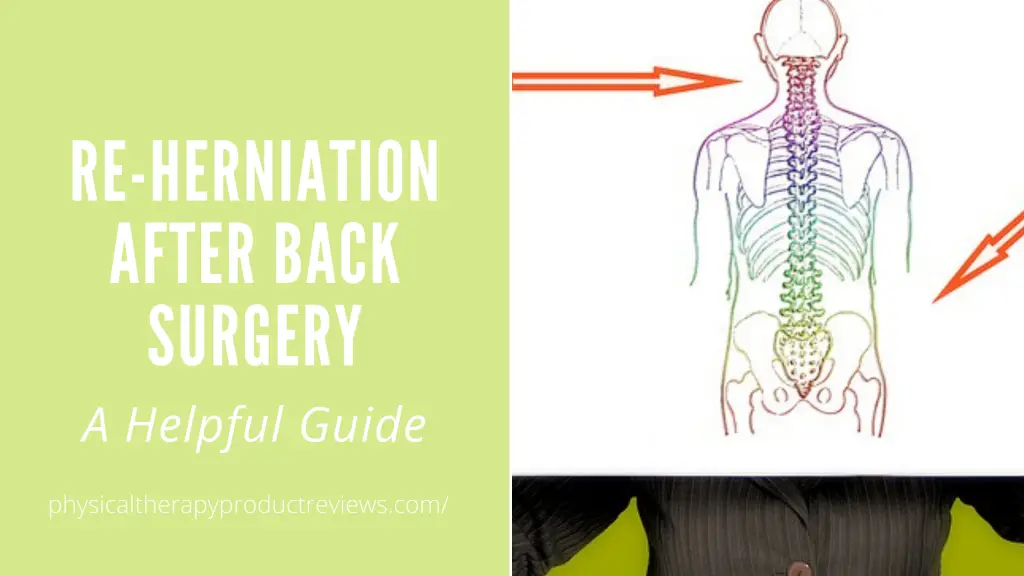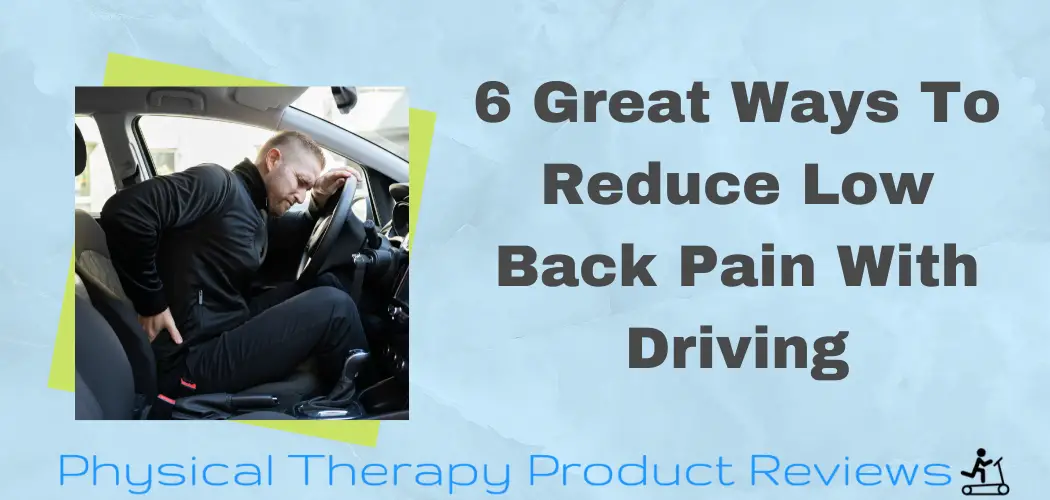A lumbar discectomy is a common procedure to correct low back pain and radicular symptoms stemming from an aggravated intervertebral disc. Though the surgery acts to correct this problem, re-injury is possible.
If you think you have experienced a re-herniation after your back surgery, let this guide help advise you on what to do and when to seek medical care.
What is a re-herniation?
Patients undergo a lumbar discectomy when a disc herniation becomes symptomatic and significantly inhibits daily life and recreation.

Re-herniation is an injury that occurs at the same level as the initial correction. This can reportedly take place anywhere from about 6 months to 8 years after the first discectomy.
Rate of occurrence: symptomatic re-herniation occurs in about 3-25% of lumbar discectomy patients.
Who is most at risk:
- Female patients are 10x as likely to experience re-herniation
- Younger patients
- Experiencing a traumatic event before the onset of symptoms
- People that use tobacco
Symptoms of a Re-herniation
- Radiating pain
- Increased pain and disability
- Neurological deficit, like numbness or weakness to the leg
A disc herniation can be confirmed through radiographic images ordered by your surgeon.
Other Back Problems After Back Surgery
 Back pain can be a result of a variety of conditions, even if you’ve had a lumbar discectomy. Your health care provider can help you rule out other issues if re-herniation is suspected.
Back pain can be a result of a variety of conditions, even if you’ve had a lumbar discectomy. Your health care provider can help you rule out other issues if re-herniation is suspected.
Increased back pain after a lumbar discectomy could result from:
- Muscular weakness of the back and core
- A compressed nerve from tight muscles
- An injury distal from the lumbar spine (like a peripheral nerve injury in the calf)
Exercises to Help after a re-herniation
 Use the following exercises to help soothe increased back pain. Be gentle with your body, keep moving, and use heat therapy (a hot pack or warm bath) to improve your comfort.
Use the following exercises to help soothe increased back pain. Be gentle with your body, keep moving, and use heat therapy (a hot pack or warm bath) to improve your comfort.
Cat and Cow
- Start on all fours, on the floor, or on top of your bed (it’s easier to get up from your bed).
- Exhale and arch your back like a cat, dipping your chin down towards your chest.
- Inhale and look up to the ceiling, letting your back curve in the opposite direction.
- Move back and forth through these positions with your breath.
Complete 12 reps and repeat throughout the day to encourage mobility.
Press-ups
- Lay on your stomach and place your hands under your shoulders.
- Gently press into your hands and lift your chest from the ground, keeping your hips in place.
- Your back will gently arch.
- This may cause some soreness in your back. If it’s tolerable, continue.
Work within your comfortable range of motion for 12 reps. Repeat throughout the day.
Nerve flossing
- Lay on your back.
- Lift one leg and reach behind your thigh to hold it up.
- Slowly extend your knee, raising your foot towards the ceiling.
- You may feel an increase in back soreness or tightness through your leg.
- Bend your knee to return to start.
Continue for 12 reps and repeat on the other side. Continue throughout the day.
Exercises to Help with a Herniated Disc
What Can you do to Prevent a Disc Re-Herniation?
You can reduce your risk of re-herniation by taking care of your body and avoiding aggravating activities.
- Avoid sitting for extended periods
- Avoid excessive weight lifting, especially in the forward-bent position
- Maintain an active lifestyle
- Stop smoking
- Work to achieve a healthy body weight
If you believe that you have experienced a re-herniation, firstly, stay calm. There are things you can do to lessen your discomfort. If the symptoms persist after a few days, contact your surgeon to discuss your concerns.
Tips:
- Keep calm & carry on! Up to one-quarter of lumbar discectomy patients may experience a re-herniation. Though unlikely, a re-herniation isn’t statistically uncommon.
- Try to self-treat for at least a few days before reaching out to your surgeon. A short-term flare-up of back pain will diffuse after a few days of conservative care, whereas a significant injury will persist.
When to Seek Medical Care After A Disc Herniation

Reach out to your surgeon if you experience the following symptoms:
- Persistent pain that lasts over a few days, especially after a traumatic event.
- The onset of neurological symptoms (like numbness and weakness).
- When your self-care has not succeeded in lessening your pain.
- Any changes to your bowel or bladder.
- Numbness or tingling to your groin region.
Your surgeon will likely recommend a round of conservative care before suggesting a surgical revision. Some patients can improve well with non-invasive procedures.
In the case of an onset of neurological symptoms and for those that have failed a round of conservative care, surgery may be a reasonable option. Progression to a second lumbar discectomy or a lumbar fusion is two possible procedures to discuss with your surgeon. In good news, both surgeries have high success rates.
Conclusion
It’s important to stay active and consistent with your exercises from physical therapy following your first lumbar discectomy. In the unlikely event that a re-herniation occurs, attempt conservative self-care for a few days before reaching out to your surgeon. Keep your head up! That’s advice for your posture and your outlook.
Works Cited
Hiubek RJ, Mundis Jr GM. Treatment for recurrent lumbar disc herniation. Current Reviews in Musculoskeletal Medicine. 2017; 10(4): 517-520. https://www.ncbi.nlm.nih.gov/pmc/articles/PMC5685971/
Martens F, Vajkcoczy P, Jadik S, Hegewald A, Stieber J, Hes R. Patients at the highest risk for reherniation following lumbar discs Tony in a multi center randomized controlled trial. JB & JS Open Access. 2018; 3(2). https://www.ncbi.nlm.nih.gov/pmc/articles/PMC6145569/
Pourahmadi MR, Taghipour M, Takamjani IE, Sanjari MA, Mohseni-Bandpei A, Keshtkar AA. Motor control exercise for symptomatic lumbar disc herniation: protocol for a systematic review and meta-analysis. British Medical Journal. 2016.https://bmjopen.bmj.com/content/bmjopen/6/9/e012426.full.pdf
Other Great Rehab Related Articles
Dealing with Painful Stairs After Ankle Replacement Surgery
Walking After a Total Ankle Replacement: Tips for a Successful Recovery
Exercises While Non-Weight Bearing After Ankle Replacement: Elevation, AROM, Leg Raises, and More
Ankle Pain with Stairs: Causes and Home Treatment Options
5 Common Mistakes You’re Making After an Ankle Sprain
6 Great Ways to Reduce Low Back Pain with Driving
Disclaimer: The information provided in this post is for educational purposes only. This is not a substitute for a medical appointment. Please refer to your physician before starting any exercise program.






